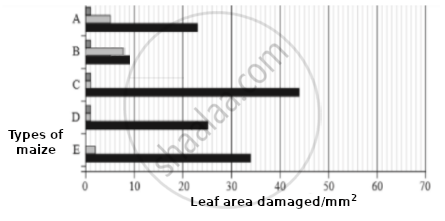Advertisements
Advertisements
प्रश्न
How has the use of Agrobacterium as vectors helped in controlling Meloidegyne incognitia infestation in tobacco plants? Explain in correct sequence.
उत्तर
The following steps were taken utilizing Agrobacterium as a transforming vector for tobacco plants to make them immune against the infestation of a nematode Meloidegyne incognitia:
1) Suitable plasmid vectors are chosen and the specific nematode gene is inserted into it.
2) The recombinant plasmids are introduced into the competent Agrobacterium cells.
3) The transformed Agrobacterium cells are screened and selected to infect the tobacco plants.
4) Agrobacterium infection on the tobacco plant cultures leads to insertion and integration of nematode-desired DNA fragment within the tobacco plant.
5) Correct insertion of nematode gene into the host tobacco plants leads to silencing of a essential housekeeping gene of the Meloidegyne incognitia pest by RNAi.
APPEARS IN
संबंधित प्रश्न
What is the major advantage of producing plants by micropropagation?
Find out what the various components of the medium used for propagation of an explants in vitro are?
Crystals of Bt toxin produced by some bacteria do not kill the bacteria themselves because −
Explain the term biofortification. How is this technique useful for the production of ‘ golden rice?
Answer the following question.
Write the desirable characters a farmer looks for in his sugarcane crop.
GM crops especially Bt crops are known to have higher resistance to pest attacks. To substantiate this an experimental study was conducted in 4 different farmlands growing Bt and non Bt-Cotton crops. The farm lands had the same dimensions, fertility and were under similar climatic conditions. The histogram below shows the usage of pesticides on Bt crops and non-Bt crops in these farm lands.

- Which of the above 4 farm lands has successfully applied the concepts of Biotechnology to show better management practices and use of agrochemicals? If you had to cultivate, which crop would you prefer (Bt or Non- Bt) and why?
- Cotton Bollworms were introduced in another experimental study on the above farm lands wherein no pesticide was used. Explain what effect would a Bt and Non Bt crop have on the pest.
Assertion (A): In Bt cotton, B. thuringiensis produces a toxic insecticidal crystalline protein which destroys bollworms.
Reason (R): B. thuringiensis produces this toxic protein in an inactive form, but when an insect ingests this inactive protein, it is converted into active form of toxin due to the alkaline pH of gut which solubilises the crystals, which is responsible for the death of bollworm.
You have identified a useful gene in bacteria. Make a flow chart of the steps that you would follow to transfer this gene to a plant.
What are the various advantages of using genetically modified plants to increase the overall yield of the crop?
Insects in the Lepidopteran group lay eggs on maize crops. The larvae on hatching feed on maize leaf and tender cob. In order to arrest the spread of three such Lepidopteran pests, Bt maize crops were introduced in an experimental field.
A study was carried out to see which of the three species of lepidopteran pests was most susceptible to Bt genes and its product.
The lepidopteran pests were allowed to feed on the same Bt-maize crops grown on 5 fields (A-E).
The graph below shows the leaf area damaged by these three pests after feeding on maize leaves for five days.

Key for lepidopteran insect pest species
 |
Species I |
 |
Species II |
 |
Species III |
Insect gut pH was recorded as 10, 8 and 6 respectively for Species I, II and III respectively.
(a) Evaluate the efficacy of the Bt crop on the feeding habits of the three species of stem borer and suggest which species is least susceptible to Bt toxin.
(b) Which species is most susceptible to Bt-maize, and explain why?
(c) Using the given information, suggest why a similar effect was not seen in the three insect species.
